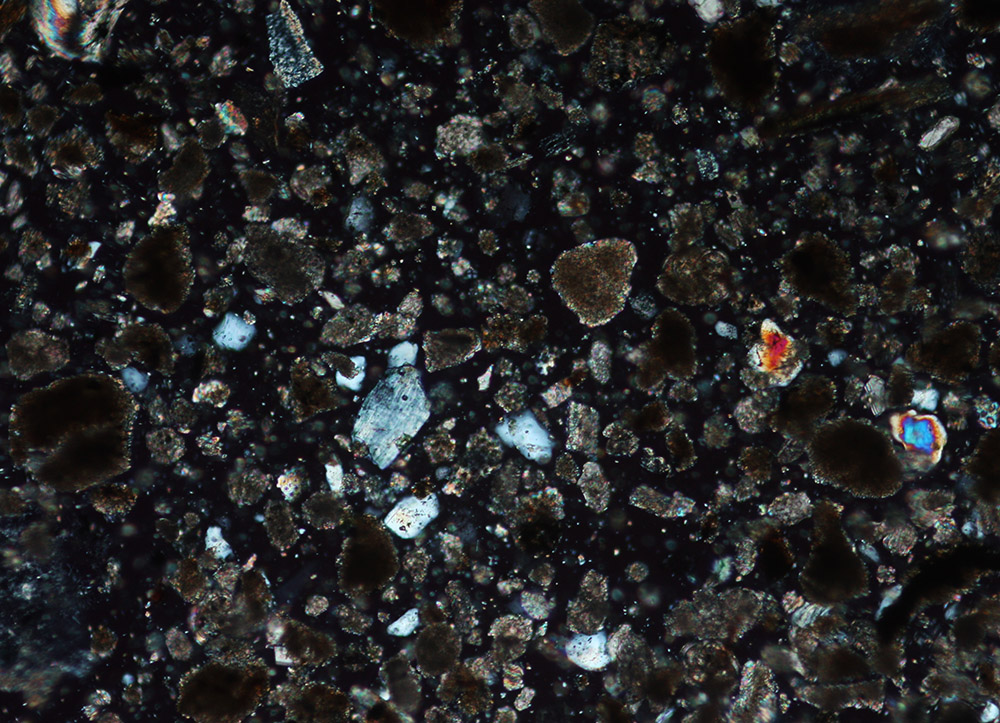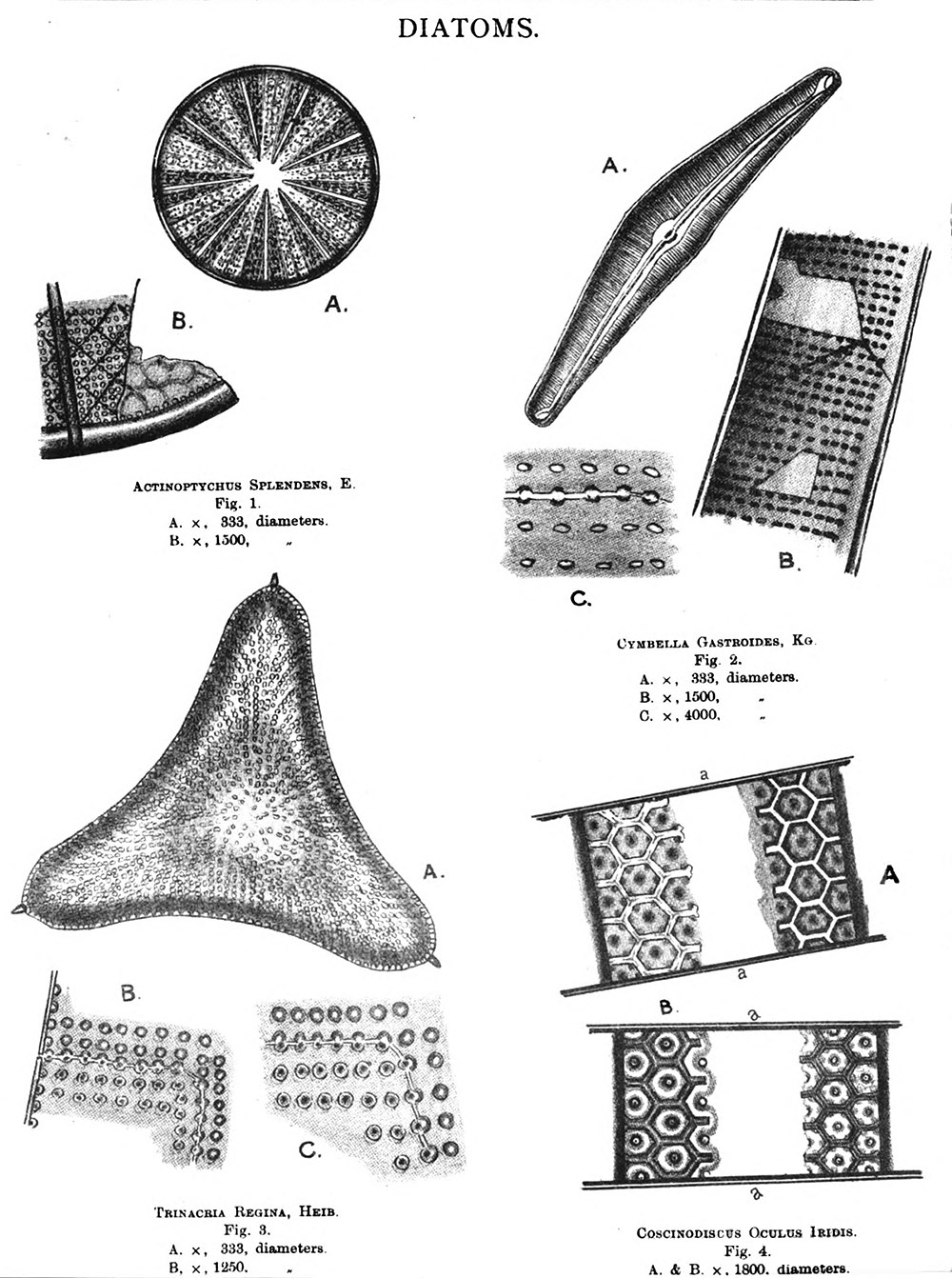Harold Goodman Dixon, 1859 - 1893
by Brian Stevenson
last updated May, 2025
Harold Dixon had only just completed his medical training when he was stricken with debilitating abscesses in his lower back. He spent most of 1884 through 1889 confined to bed in a hospital convalescent ward, but during that time and two brief periods of release, Dixon explored his interests in the sciences. A colleague wrote that the bed-bound Dixon, “used to examine microscopical specimens, and give opinions on slides of bacilli or growths submitted to him”. A number of permanent microscope slides are known that bear Harold G. Dixon’s name (Figure 1). Some were prepared by him, while others were acquired from professional slide-makers for his study. His slides carry labels printed with “Cambs. & Guy’s”, indicating Dixon’s undergraduate education at Cambridge University and his medical training at Guy’s Hospital.

Figure 1.
Two of Harold G. Dixon’s microscope slides. Both are dated November, 1887, which was near the beginning of his third, extended convalescent stay in Luke Ward, Guy’s & St. Thomas’ Hospital. Dixon probably made the slide on the left, either from material he had collected before his stay or brought to him by a colleague. Note that he labeled this slide "No. 294" and "No. 295", implying that it was one of a substantial number of specimens that he mounted. The slide on the right was purchased by Dixon, as the descriptive label bears the handwriting of professional slide-maker Jean C. Tempère. From the author’s collection or adapted for nonprofit, educational purposes from an internet auction site.

Figure 2.
Sand from Valesia Harbor, mounted by H.G. Dixon on November 20, 1887 (see Figure 1).
Photographed with a 3.5x objective lens, crossed polarizing filters, and a C-mounted digital SLR camera on a Leitz Ortholux II microscope.
Harold Goodman Dixon was the eldest of four children of Robert and Susan Dixon. He was born on November 7, 1859 in Wickham Bishops, Essex. Father Robert was a wealthy landowner, miller, and farmer.
Harold attended private schools, then entered Cambridge University in 1876. He received his B.A. in 1879. Medical training followed, completing his M.B. in 1882. He then entered Guy’s Hospital, London for further training, passing his first examinations for Fellow of the Royal College of Surgeons in 1883.
A colleague, Walter Jacobson, described Dixon during his days at Guy’s: “the slight, active figure, the intelligent eyes behind the spectacles, the gentle smile, the genial voice, and lastly - whether the day was bitter with frost or glowing bright with summer's sunshine - some flower or green leaves in his button hole … Though very shortsighted and of somewhat frail physique, he could take his part in rowing, cycling, fishing, skating”.
Jacobson also wrote, “In April, 1884, while Dixon was holding the appointment of medical ward clerk, the shadow of what was coming fell across his path with girdle-pains and prominence and tenderness of the twelfth dorsal spine. It would appear that in 1879 he had had somewhat similar pains after a fall, followed by an abscess over the right sacroiliac joint. Treatment by Sayre's jackets was first tried, and in October, 1884, Mr. Davies-Colley opened spinal abscesses which occupied the iliac and lumbar regions on both sides, about three pints of pus coming away. Dixon was now in Luke ward from October, 1884, to September, 1885. He then went into the country with a small sinus, which closed only to re-open quickly. He again lay in Luke ward from January, 1886, to June, 1887, when he went out with a Sayre's jacket, in which a small window permitted the dressing of a sinus. Within a month he was obliged to return to Luke ward for the third and longest period, viz., from July, 1887, to July, 1889. In August, 1889, both sinuses were explored and opened up, but no diseased bone that could be removed was found”.
A ”Sayre's jacket” is a plaster of Paris cast that is used to support the backbone when the vertebrae have been severely damaged by disease. The nature of Dixon’s abscesses were not reported. “Luke ward” was, and still is, a ward for long-term convalescence at Guy’s & St. Thomas’ Hospital.
The microscope slides shown in Figure 1 are dated November, 1887, four months after Dixon was confined for his “third and longest period”.
Jacobson wrote that Dixon was not idle during his days in the convalescent ward, “Some may remember the decorations in Luke ward at Christmas, 1886, a time when Dixon was spending there his second period, lasting one and a half years. The decorations were then unique, shields being placed above the beds carrying the heads and wings of various birds, most of which were prepared by him ... Other instances of his energy, enterprise, and habitual occupation of his time usefully were seen in his wood-carving. Thus he used to decorate small boxes and photograph frames, by most effectively carving out a white pattern on a dark ground. This he accomplished lying on his back; he used to crane his neck in order to throw his head well forward on to his chest, at the same time drawing up his knees in bed, and placing the work which he was carving against them. By a somewhat similar feat he used to examine microscopical specimens, and give opinions on slides of bacilli or growths submitted to him”.
Late in the summer of 1889, arrangements were made for Dixon to stay at a convalescent home in Shanklin, Isle of Wight. His sister, Helen, accompanied him there.
Jacobson wrote, “At first his health improved, and, recumbent on his stretcher, he was often taken for a sail or row by a sailor”. While at the Isle of Wight, Dixon wrote an article on diatoms that was published during 1889 in the Guy's Hospital Gazette. Dixon drew the figures that accompanied his paper (Figure 3). In 1890, he wrote a letter to Nature on his experiences during earthquakes.
But, “The power of sound repair was, however, lacking, a sinus on the right side persisted, while that on the left occasionally reopened. About March, 1892, the beginning of the end, in the form of albuminuria, appeared; from this time Dixon slowly lost flesh and strength, until on March 5th, 1893, this most guileless of men, this truest of friends, and most patient of sufferers, placide conquievit.”

Figure 3.
“Diatoms”, drawn by Harold G. Dixon for his 1889 article that was published in “Guy's Hospital Gazette”. He wrote, “I have chosen to sketch valves shewing fractures of their walls, as the fracture gives a little more insight into the character of the areolations.”
Resources
Dixon, Harold G. (1889) Diatoms, Guy's Hospital Gazette, page 60
Dixon, Harold G. (1890) The mode of observing the phenomena of earthquakes, Nature, page 491
England census and other records, accessed through ancestry.com
Jacobson, Walter H.A. (1893) Harold Goodman Dixon, Guy's Hospital Gazette, pages 122-124
Probate of the will of Harold Dixon (1893) “Dixon Harold Goodman of Esher house Shanklin Isle of Wight died 5 March 1893 Probate London 11 April to Albert Goodman gentleman Effects £425 12s 6d”, accessed through ancestry.com


